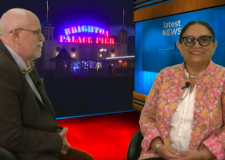Science: Unlocking Potential
Dr Caroline Oprandi keeping you up to date with science & technology at PACA
The study of light is such an interesting topic. Pure white light that reaches us from the sun is in fact made up of a blend of different colours and Sir Isaac Newton demonstrated this in 1966 using a prism. 
The light that is visible to our eyes all lies within a very narrow range of wavelengths, between 390 and 740 nm. There is nothing very special about visible light. Its only specific significance is that this is one of the few wavebands for which earth’s atmosphere is transparent, and therefore most life on earth has evolved to take advantage of it through a variety of organs, most obviously the eyes. Giles Sparrow gives a brilliant account of light and electromagnetism in his little pocket book ‘Physics in minutes’.
Giles Sparrow goes onto say that electromagnetic waves are one of the key ways in which we can learn about the universe. The most obvious form of electromagnetism is visible light but this is only a very small part of the wider electromagnetic spectrum, which includes invisible radiations such as infrared, ultraviolet and x-rays. All electromagnetic waves travel through space (a vacuum) at the same speed (300 million m/s) but they have different wavelengths and frequencies. The waves are grouped according to their wavelength and frequency. The order of the electromagnetic spectrum starting with the shortest wavelength and highest frequency is as follows: gamma rays, x-rays, ultraviolet light, visible light, microwaves, radio waves.
I find it fascinating that human beings have gone on to discover these different aspects of the electromagnetic spectrum and furthermore have found ways to manipulate and utilise them. Percy Spencer, an American self-taught engineer, was working in a lab testing magnetrons when he noticed a peanut butter candy bar in his pocket had begun to melt. Two years later, with his newfound knowledge on how to cook food in mere seconds, Spencer and his employer, Raytheon, patented the first commercial microwave oven – it cost $5,000. A countertop microwave oven in 1975 cost $672.
We now have microwave telescopes that can allow us to see the sky in microwave frequencies. There are microwave sources that are invisible to optical telescopes, and there may be gas or dust clouds that block visible light but allow some microwaves to penetrate. Almost everywhere in space we see microwave radiation, and that microwave radiation is the “echo” of the Big Bang. It’s called cosmic microwave background radiation (CMBR), and again was discovered by chance.
Portslade Aldridge Community Academy (PACA) is a college offering sixth form, 11-16 years, youth centre, adult learning, community education, sports centre and pre-school. Find out more at www.paca.uk.com




















